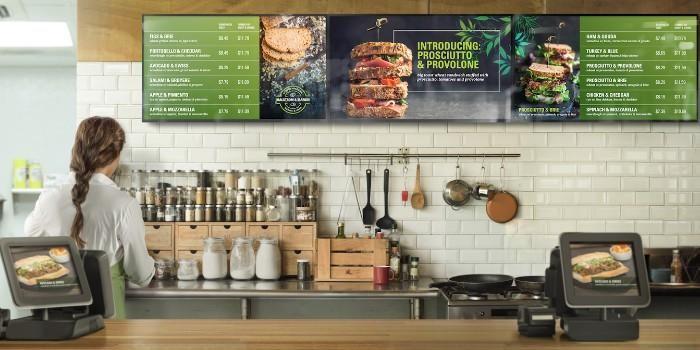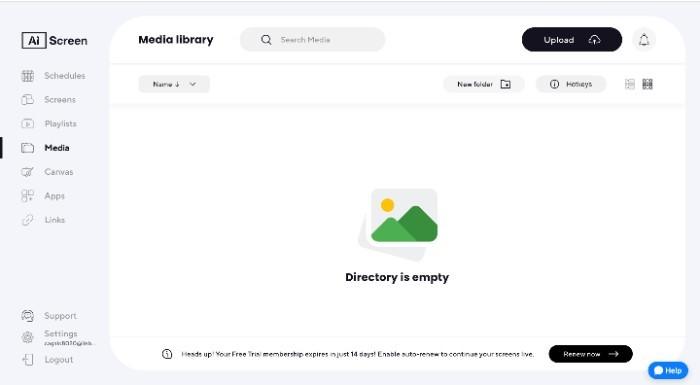Last Updated on June 13, 2025
- How to gain buy-in for digital signage?
- What preparations are necessary to establish the setup?
- Define your audience and determine their desires and preferences
- What strategies will you employ to generate content?
- Who will oversee the management of your displays, and when?
- How will you measure the performance of your digital signage displays?
- FAQs
One of the aspects we appreciate about digital signage is that it promotes fairness. Unlike social media, pay-per-click (PPC), and online advertising, where coverage is often determined by budget, digital signage allows businesses of all sizes to compete equally.
With digital signage, the cost of setting up and rolling out is determined by the number of screens you use rather than the number of competing companies.
Digital signage is a versatile tool that anyone can easily set up. The best part is that it offers advantages such as swift decision-making and familiarity with regular customers, which can significantly impact small businesses.
One could argue that digital signage is a marketing strategy that favors small businesses. Here are a few key benefits:
Versatile
Consider your current business objective: increasing sales, boosting employee engagement, or enhancing customer service. Digital signage can be a valuable solution that addresses a wide range of goals for small businesses. The technology behind digital signage is straightforward, but how you implement and customize it, and your content is entirely up to your preferences and requirements.
Adjustable
Unlike printing brochures or setting up a new website, which can be challenging to modify in response to evolving business needs, digital signage allows for rapid adjustments as soon as you conceive them. This flexibility enables quick and seamless updates to meet your business requirements.
Highly Engaging
When individuals encounter a screen, they are naturally drawn to watch it. Research indicates that screens have a stunning effect as a medium, which is unsurprising given our increasing reliance on devices and constant screen usage.
Affordable
Digital signage is remarkably cost-effective. For instance, AIScreen Signage software offers affordable options for businesses. The software is compatible with all types of screens and the cost is only $9 per screen per month. That is why you can start with just one screen and see how it goes without needing a large-scale rollout or multiple screens.
Now that you know the advantages, here is a comprehensive guide on effectively implementing digital signage for your small business.
How to gain buy-in for digital signage?
Convince and Convert can be your entry point if you are new to digital signage. Unfortunately, many people may not be familiar with this medium, and even if they are, they might not realize its potential.
With numerous screens often left blank or displaying repetitive content on a loop, it is understandable why some might view digital signage as a waste of time.
If you require approval from higher-ups, your initial step is to obtain their buy-in.
Consider utilizing what you already have, such as new screens. Then, you can use our hardware selector tool to explore the possibilities and see what you could do with them.
You may even want to create a digital signage business plan. Note down your objectives, the vision for the screens, and specific business goals, as well as how you measure them.
You may also need to gain support from your staff. Many business owners we have spoken to are enthusiastic about setting up digital screens but express maintenance concerns.
Ensuring that your staff understands how the screens work is crucial to keep the content relevant and adaptable to your business needs. For instance, in a restaurant, staff must be able to change digital menus. In an office setting, your marketing team should control the screens and the content they display.
Clear understanding among staff can facilitate a smooth operation and effective management of your digital signage system. Consider how your staff can actively participate and take ownership of digital signage as a project, which can help alleviate some of the initial pressures.
When employees are engaged and invested in the medium, it can foster a sense of ownership and responsibility, leading to smoother implementation and management of the digital signage initiative.
👉 Free Download: AirDroid Business MDM For Digital Signage Management
Experience monitoring signage screens in bulk, customizing interface, pushing app update automatically, and remotely controlling your digital signage anytime.
What preparations are necessary to establish the setup?
To put it simply, digital signage necessitates three essential elements:
- A display that is connected to the internet
- Digital signage management software
- A desktop or laptop-based for managing digital signage software
To get started, assess the screens you currently have or plan to purchase and confirm that they are “smart” screens.
Then, create an account with a digital signage software management tool. We suggest doing this on your PC or laptop, although a phone or tablet can also be used if necessary. Once the account is set up, proceed to pair the screen with your account.
Define your audience and determine their desires and preferences
Before you decide on the content to display, let’s take a moment to pause and reflect. It can be tempting to quickly display readily available content, such as social media posts or images.
However, aligning your objectives with your audience’s preferences is crucial. Here is the key: in B2C (business-to-consumer) digital signage, the content should cater to your customers’ needs. B2B (business-to-business) should cater to clients, stakeholders, or staff members.
For example, if you run a quick-service restaurant and your objective is to reduce perceived wait time, you can leverage digital signage to achieve this.
You could use the prominently placed displays to provide real-time updates to customers about their food or table wait times, helping to manage their expectations and enhance their experience.
This benefits the customers by preventing boredom, empowering them to feel in control of their experience, and making their perceived wait time seem shorter.
Consider a new scenario: if your retail store aims to increase the visibility of your products, displaying images of your new products on the screen may not necessarily serve your audience and their goals.
However, with a few adjustments, it could. For example, with a digital signage for a gas station solution, instead of showing the products directly, you could display information on where the customers can find the products, making their search more efficient. To take it a step further, integrating QR codes allows customers to quickly access product details, discounts, or even digital loyalty cards right from their phones, enhancing both engagement and convenience.
Alternatively, you could showcase an exclusive offer or a countdown to your seasonal sale to entice customers and create a sense of urgency. Now they can save money by taking advantage of the discount offered for following you on Twitter or referring a friend.
This creates a win-win situation where you benefit from a referral, and they get more value for their money.
What you desire and what your audience desires are not fundamentally different; you need to find a way to align the two and create a mutually beneficial situation.
What strategies will you employ to generate content?
Only a little about this step – even with marketing or design expertise, you can easily create compelling content for your small business.
When referring to content, this could include:
Slides – showreels, presentations, or slides that serve as the foundation for showcasing special offers, digital menus, or promotions.
Videos – Digital signage is similar to TV, so videos are often a practical choice. You can use owned videos or stream videos from channels like YouTube or Vimeo. You could also incorporate a live news stream or similar content.
Social media – Display dashboards and live feeds from your tweets or Facebook page optimized for your digital screen to ensure a polished appearance.
Company information – Easily share project processes, health and safety information, Trello boards, Slack conversations, or any other relevant company information on your digital screen.
Regarding the practical aspects, three straightforward methods exist for identifying and displaying content on your digital screen.
Content that you already possess
What do you already have at your disposal? Are there videos, images, or presentations that are relatively current? Digital Signage Software accommodates various file types, including JPEG, GIF, PNG, SVG, PDFs, and Office/iWork formats, making it simple to upload content.
You also have the option to directly import from your Google Docs.
The App Store is brimming with tools eagerly waiting to help make this a reality.
You can easily configure digital menu boards, noticeboards, dashboards, and data visualizations here. Plus, you can import content seamlessly from Google Spreadsheets and Google Slides.
Who will oversee the management of your displays, and when?
This is especially vital in small businesses where roles and responsibilities are often distributed among a limited number of individuals. For some small businesses, we collaborate with the CEO or business owner to conceptualize the idea, which gets delegated to either the marketing or IT department for implementation.
The choice of who manages digital signage technology can vary depending on your business model, but ultimately, it can be handled by anyone who understands your business and its goals.
Digital signage is not overly technical, and numerous tools are available that simplify the challenging aspects, such as content creation. As a result, it is a task that anyone can easily handle. We have witnessed displays managed by various individuals, including teachers, HR assistants, office managers, chefs, and store staff.
Consider establishing a system for updating your displays, whether weekly, monthly, quarterly, or seasonal. For instance, you could have a set of five “fixed” content pieces and periodically add new slides, images, or graphics when you have noteworthy announcements or updates to share.
Establishing these guidelines from the outset helps prevent your displays from falling into a “set it and forget it” mentality, which defeats the purpose of having them in the first place!
How will you measure the performance of your digital signage displays?
You do not necessarily need a rigid KPI structure to determine if your digital screens are effective. Many of the impacts can be observed firsthand.
For instance, you may notice customers complaining less about wait times, receiving more positive Yelp reviews, or showing an increased interest in specific products.
You can also establish return on objectives (ROO) to measure the alignment of your efforts with the top-line goals of your organization.
This could encompass increased customer satisfaction, higher employee engagement, or faster response times on social media.
Establishing goals provides a benchmark for everyone to strive towards and can boost morale within a small business.

FAQs
How much does it cost to install digital signage?
The cost of digital signage typically ranges from $10 to $30 per month, depending on the level of professionalism of the software and the associated services. This pricing typically includes technical support and software updates. Additionally, there is also on-premise best digital signage software available.
What are the disadvantages of digital signage?
Here are five disadvantages of digital signage:
- Initial Cost: Digital signage may require a substantial upfront investment in hardware and software, which can be a barrier for small businesses.
- Technical Issues: Like any technological solution, digital signage may encounter technical glitches or challenges that need to be addressed.
- Security Risks: Digital signage systems may be vulnerable to security breaches or unauthorized access, posing potential risks to sensitive information or content.
- Content Management: Managing and updating content on digital signage screens can be time-consuming and may require technical expertise, posing challenges for businesses with limited resources or technical skills.
- Limited Reach: Digital sign screens are limited to the locations where they are physically installed, which may restrict their reach and impact compared to other marketing channels.
How do I start my own digital signage?
Below is a step-by-step process for implementing digital signage. Please note that the order of the steps may vary depending on your specific requirements and preferences.
- Set Measurable Objectives: Define clear and measurable objectives for your digital signage campaign. What do you want to achieve with your signage displays? Examples include increasing sales, improving customer engagement, or enhancing brand awareness.
- Define Your Target Audience: Identify your target audience for the digital signage campaign. Who are you trying to reach with your displays? Understanding your audience will help you create relevant and effective content that resonates with them.
- Create Engaging Content: Develop engaging and visually appealing content for your digital signage displays. This may include images, videos, animations, and text that align with your objectives and resonate with your target audience.
- Plan Locations and Installation: Decide on the optimal locations for your digital signage displays based on your target audience and campaign objectives. Consider factors such as foot traffic, visibility, and accessibility. Plan the installation process, including any necessary hardware, cabling, and mounting requirements.
- Design a Content Schedule: Create a content schedule that outlines the timing and frequency of content updates for your digital signage displays. This may include regular updates, seasonal promotions, or timely announcements. Ensure that your content schedule aligns with your campaign objectives and keeps your displays fresh and engaging.
- Choose Supportive Hardware: Select appropriate hardware for your digital signage displays, such as displays, media players, and content management systems. Consider factors such as display size, resolution, connectivity, and compatibility with your content creation and management software.
- Review Your System’s Success: Regularly review and assess the success of your digital signage campaign based on your defined objectives. Measure key performance indicators (KPIs) such as sales data, customer feedback, and engagement metrics to evaluate the effectiveness of your digital signage displays. Use this data to make informed decisions and optimize your campaign for better results.

Author’s Bio: Nikita Sherbina is a writer, content marketing consultant, and strategic partnerships manager for big brands. With 10+ years of digital marketing experience, he is passionate about leveraging SaaS, marketing, and online business space to scale digital growth. Nikita lives in Seattle, WA, and writes about marketing, digital signage, and scaling your branding influence on his blog, aiscreen.io.









A successful digital signage strategy requires careful planning and execution. Start by identifying what you want to achieve with digital signage. Is it to increase brand awareness, boost sales, enhance customer experience, or provide information? Setting clear goals will guide your strategy.